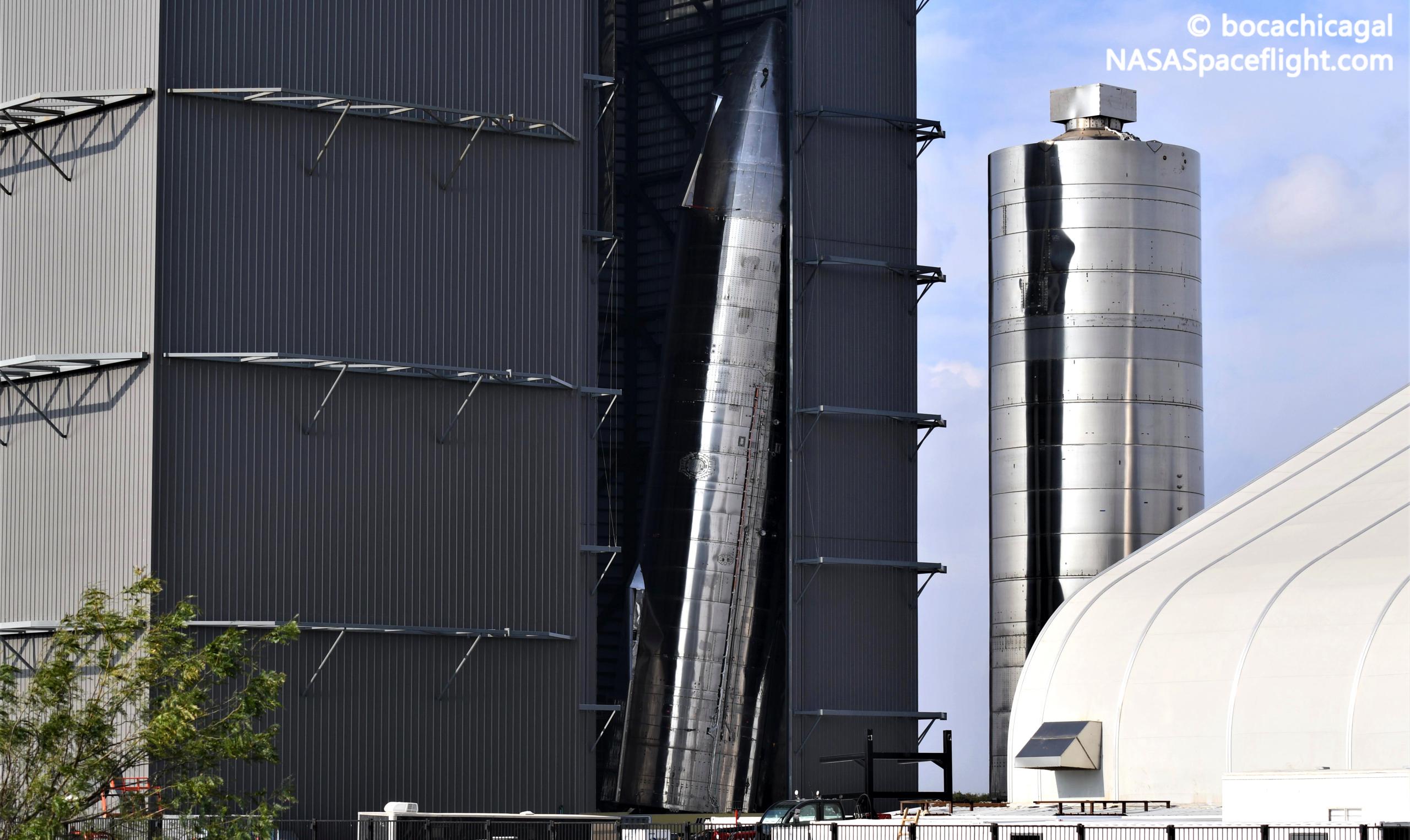
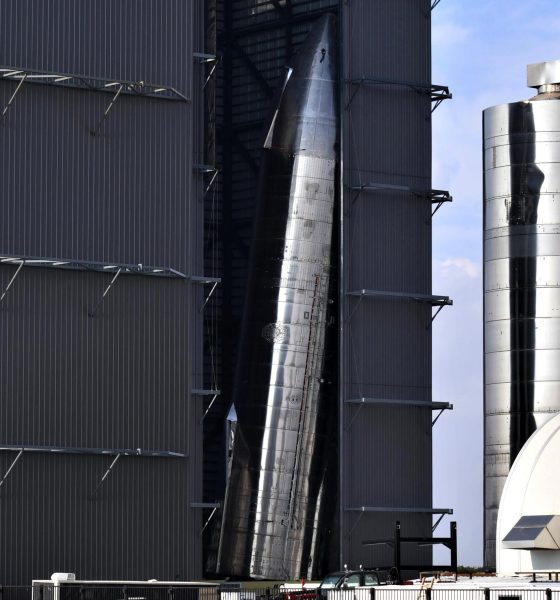
News
SpaceX almost drops finished Starship prototype – but it might be salvageable
Less than 48 hours after Starship SN8’s (successful) demise, something on or around a metal stand holding up SpaceX’s next completed Starship collapsed, causing the rocket to rapidly tilt sidewise and smash into the assembly building containing it.
Put simply, launch vehicles very rarely designed or expected to survive the kind of structural loads the fall and impact put Starship SN9 through and the early prognosis – prior to any up-close observation – was not not great. Weighing at least 50-70 metric tons (110,000-155,000 lb), any other rocket – and possibly even Starship itself – should have been damaged beyond repair from anything less than a minor bump.
Instead, Starship SN9 – fully assembled and perhaps just a few days away from a scheduled transport to the launch pad – shifted some 10 degrees (~10 m/30 ft) in a few seconds, seemingly coming to rest against scaffolding and the interior wall of SpaceX’s “high bay” assembly building. Had Starship fallen 180 degrees in the opposite direction, the results could have been catastrophic, potentially falling without a wall to stop it onto a Super Heavy booster section that could have had workers inside it. Luckily, the (hopeful) wakeup call was apparently benign, with SpaceX escaping loss of life or limb and avoiding any catastrophic damage.
Perhaps even worse, less than a day prior, a number of VIPs, SpaceX executives, investors, and even Elon Musk himself were touring the company’s Starship factory and standing feet away from SN9 itself. The most likely culprit of SN9’s fall may even be visible in photos taken by Steve Jurvetson, one such investor. In a few of those photos, Starship’s steel work stand – a staple of SpaceX’s Starship factories for ~18 months – appears to be precariously balanced upon five or six jacks with nothing more than gravity, SN9’s own mass, and some counterweights hold them together.
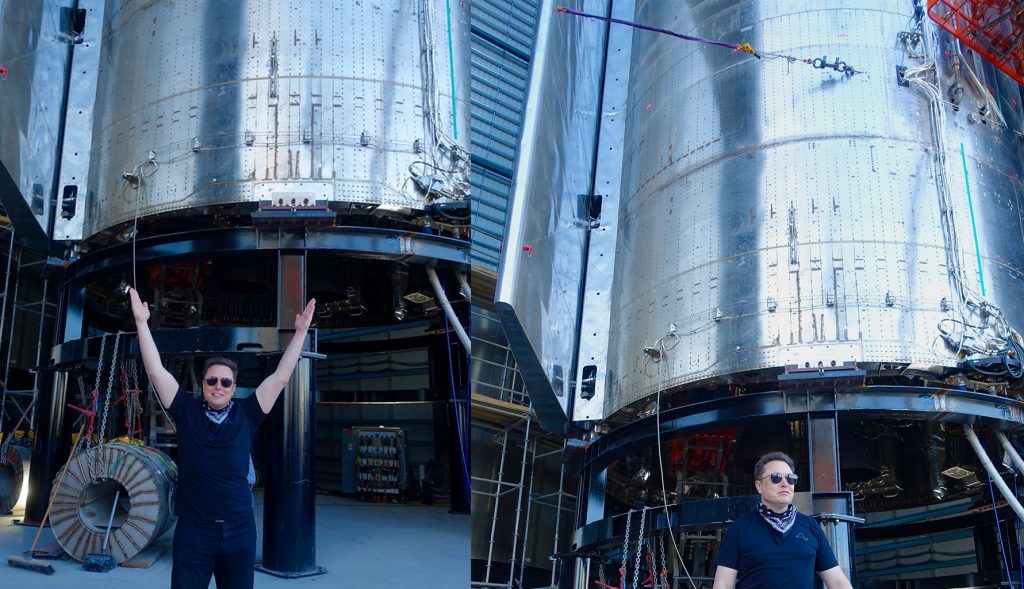
If those jacks – as they appear to be – weren’t bolted to the high bay’s concrete foundation or Starship SN9’s work stand, it could have been unintuitively easy to trigger a collapse like the one that occurred, perhaps requiring a minor bump with a forklift, a particularly extreme gust of wind, or some other kind of lateral force.
Regardless of why it happened, the end result was the same. Somewhat miraculously, Starship SN9 – as photos would soon show – appeared to be almost entirely unscathed, baring no obvious hull damage. The rocket’s fore and aft starboard flaps, however, were clearly crumpled. In fact, it’s possible that the crumpling of those largely empty, thin-skinned flaps acted just like the crumple zones designed into modern cars, essentially soaking up the energy of SN9’s impact with the wall and saving the rest of the rocket.
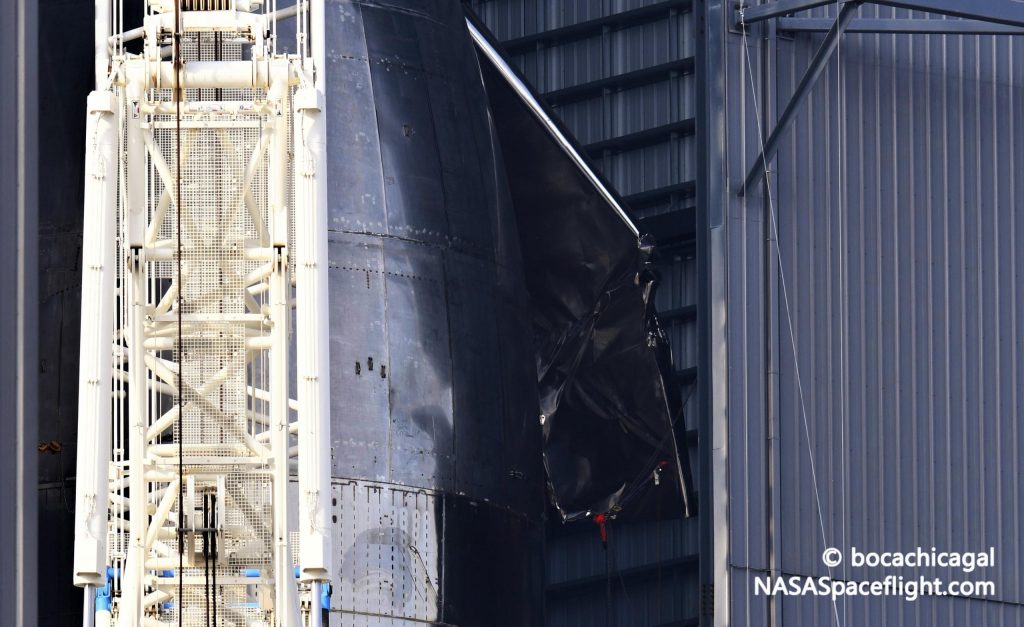
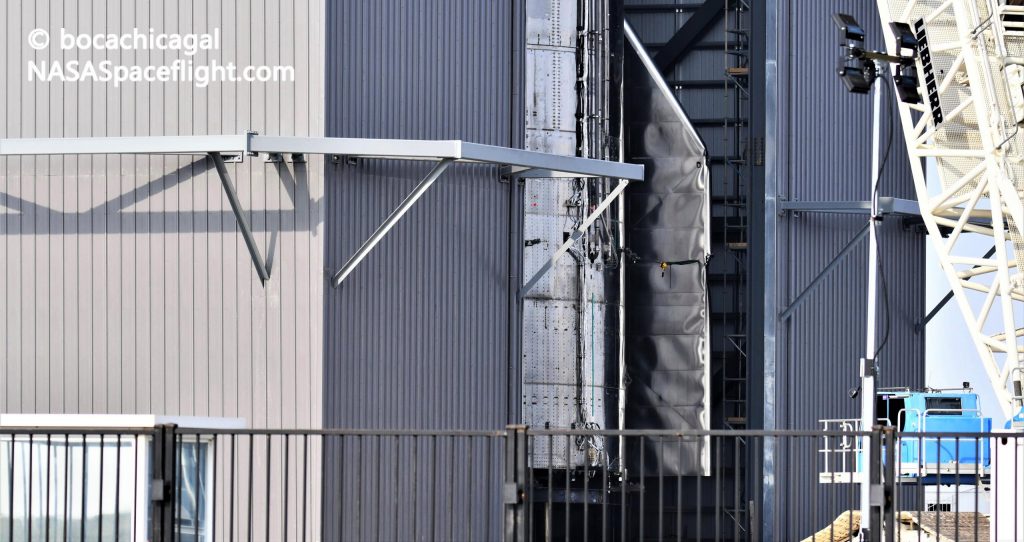
Still, the reality is that Starship SN9’s prognosis is still unlikely to be good, even if crumpling flaps seemingly prevented the rocket from becoming an unequivocal write-off. Depending on how strong SN9’s flaps were, the force of the impact could have easily been transferred into the structural hinges that connect them to Starship, warping internal stiffeners, the hinge mechanism itself, or even the entire curvature of its cylindrical steel hull.
If somehow limited to just the hinges or, even less likely, if the flaps took almost all of the impact energy, SN9 might be repairable. Even then, it’s unlikely that SpaceX will be able to hold to the schedule previously discussed on Teslarati, meaning that Starship SN9’s journey to the launch pad probably isn’t going to happen on Monday, December 14th. In the meantime, SpaceX will likely kick work on Starship SN10 – perhaps just a week or two behind SN9 – into full gear.

News
Elon Musk’s Grokipedia surges to 5.6M articles, almost 79% of English Wikipedia
The explosive growth marks a major milestone for the AI-powered online encyclopedia, which was launched by Elon Musk’s xAI just months ago.

Elon Musk’s Grokipedia has grown to an impressive 5,615,201 articles as of today, closing in on 79% of the English Wikipedia’s current total of 7,119,376 articles.
The explosive growth marks a major milestone for the AI-powered online encyclopedia, which was launched by Elon Musk’s xAI just months ago. Needless to say, it would only be a matter of time before Grokipedia exceeds English Wikipedia in sheer volume.
Grokipedia’s rapid growth
xAI’s vision for Grokipedia emphasizes neutrality, while Grok’s reasoning capabilities allow for fast drafting and fact-checking. When Elon Musk announced the initiative in late September 2025, he noted that Grokipedia would be an improvement to Wikipedia because it would be designed to avoid bias.
At the time, Musk noted that Grokipedia “is a necessary step towards the xAI goal of understanding the Universe.”
Grokipedia was launched in late October, and while xAI was careful to list it only as Version 0.1 at the time, the online encyclopedia immediately earned praise. Wikipedia co-founder Larry Sanger highlighted the project’s innovative approach, noting how it leverages AI to fill knowledge gaps and enable rapid updates. Netizens also observed how Grokipedia tends to present articles in a more objective manner compared to Wikipedia, which is edited by humans.
Elon Musk’s ambitious plans
With 5,615,201 total articles, Grokipedia has now grown to almost 79% of English Wikipedia’s article base. This is incredibly quick, though Grokipedia remains text-only for now. xAI, for its part, has now updated the online encyclopedia’s iteration to v0.2.
Elon Musk has shared bold ideas for Grokipedia, including sending a record of the entire knowledge base to space as part of xAI’s mission to preserve and expand human understanding. At some point, Musk stated that Grokipedia will be renamed to Encyclopedia Galactica, and it will be sent to the cosmos.
“When Grokipedia is good enough (long way to go), we will change the name to Encyclopedia Galactica. It will be an open source distillation of all knowledge, including audio, images and video. Join xAI to help build the sci-fi version of the Library of Alexandria!” Musk wrote, adding in a later post that “Copies will be etched in stone and sent to the Moon, Mars and beyond. This time, it will not be lost.”
News
Tesla Model 3 becomes Netherlands’ best-selling used EV in 2025
More than one in ten second-hand electric cars sold in the country last year was a Tesla Model 3.

The Tesla Model 3 became the most popular used electric car in the Netherlands in 2025, cementing its dominance well beyond the country’s new-car market.
After years at the top of Dutch EV sales charts, the Model 3 now leads the country’s second-hand EV market by a wide margin, as record used-car purchases pushed electric vehicles further into the mainstream.
Model 3 takes a commanding lead
The Netherlands recorded more than 2.1 million used car sales last year, the highest level on record. Of those, roughly 4.8%, or about 102,000 vehicles, were electric. Within that growing segment, the Tesla Model 3 stood far ahead of its competitors.
In 2025 alone, 11,338 used Model 3s changed hands, giving the car an 11.1% share of the country’s entire used EV market. That means more than one in ten second-hand electric cars sold in the country last year was a Tesla Model 3, Auto Week Netherlands reported. The scale of its lead is striking: the gap between the Model 3 and the second-place finisher, the Volkswagen ID3, is more than 6,700 vehicles.
Rivals trail as residual values shape rankings
The Volkswagen ID.3 ranked a distant second, with 4,595 used units sold and a 4.5% market share. Close behind was the Audi e-tron, which placed third with 4,236 registrations. As noted by Auto Week Netherlands, relatively low residual values likely boosted the e-tron’s appeal in the used market, despite its higher original price.
Other strong performers included the Kia Niro, the Tesla Model Y, and the Hyundai Kona, highlighting continued demand for compact and midsize electric vehicles with proven range and reliability. No other model, however, came close to matching the Model 3’s scale or market presence.
News
Tesla Model Y Standard Long Range RWD launches in Europe
The update was announced by Tesla Europe & Middle East in a post on its official social media account on X.

Tesla has expanded the Model Y lineup in Europe with the introduction of the Standard Long Range RWD variant, which offers an impressive 657 km of WLTP range.
The update was announced by Tesla Europe & Middle East in a post on its official social media account on X.
Model Y Standard Long Range RWD Details
Tesla Europe & Middle East highlighted some of the Model Y Standard Long Range RWD’s most notable specs, from its 657 km of WLTP range to its 2,118 liters of cargo volume. More importantly, Tesla also noted that the newly released variant only consumes 12.7 kWh per 100 km, making it the most efficient Model Y to date.
The Model Y Standard provides a lower entry point for consumers who wish to enter the Tesla ecosystem at the lowest possible price. While the Model 3 Standard is still more affordable, some consumers might prefer the Model Y Standard due to its larger size and crossover form factor. The fact that the Model Y Standard is equipped with Tesla’s AI4 computer also makes it ready for FSD’s eventual rollout to the region.
Top Gear’s Model Y Standard review
Top Gear‘s recent review of the Tesla Model Y Standard highlighted some of the vehicle’s most notable features, such as its impressive real-world range, stellar infotainment system, and spacious interior. As per the publication, the Model Y Standard still retains a lot of what makes Tesla’s vehicles well-rounded, even if it’s been equipped with a simplified interior.
Top Gear compared the Model Y Standard to its rivals in the same segment. “The introduction of the Standard trim brings the Model Y in line with the entry price of most of its closest competition. In fact, it’s actually cheaper than a Peugeot e-3008 and costs £5k less than an entry-level Audi Q4 e-tron. It also makes the Ford Mustang Mach-E look a little short with its higher entry price and worse range,” the publication wrote.








